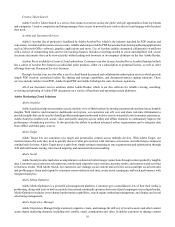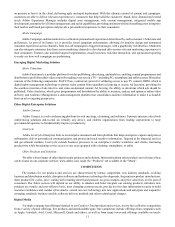Adobe 2014 Annual Report Download - page 19
Download and view the complete annual report
Please find page 19 of the 2014 Adobe annual report below. You can navigate through the pages in the report by either clicking on the pages listed below, or by using the keyword search tool below to find specific information within the annual report.19
exclusive distribution for certain platforms, which may make it more difficult for us to compete in these markets. If any competing
products, services or operating systems (that don’t support our solutions) achieve widespread acceptance, our operating results
could suffer. In addition, consolidation has occurred among some of the competitors in the markets in which we compete. Further
consolidations in these markets may subject us to increased competitive pressures and may therefore harm our results of operations.
For additional information regarding our competition and the risks arising out of the competitive environment in which we
operate, see the section entitled “Competition” contained in Item 1 of this report.
If we fail to successfully manage transitions to new business models and markets, our results of operations could suffer.
We often release new offerings and employ new software and services delivery methods in connection with our diversification
into new business models and markets. It is uncertain whether these strategies will prove successful or whether we will be able to
develop the necessary infrastructure and business models more quickly than our competitors. Market acceptance of new product
and service offerings will be dependent on our ability (1) to include functionality and usability that address certain customer
requirements where our operating history is less extensive, and (2) to optimally price our products in light of marketplace conditions,
our costs and customer demand. New product and service offerings could subject us to increased risk of liability related to the
provision of services as well as cause us to incur significant technical, legal or other costs. For example, with our cloud-based
services and subscription-based licensing models, such as Creative Cloud, we have entered markets that may not be fully accustomed
to cloud-based subscription offerings. Market acceptance of such services is affected by a variety of factors, including information
security, reliability, performance, social/community engagement, local government regulations regarding online services and user-
generated content, the sufficiency of technological infrastructure to support our products in certain geographies, customer concerns
with entrusting a third party to store and manage their data, public concerns regarding data privacy and the enactment of laws or
regulations that restrict our ability to provide such services to customers in the U.S. or internationally. If we are unable to respond
to these threats, our business could be harmed.
From time to time we open-source certain of our technology initiatives, provide broader open access to our technology,
license certain of our technology on a royalty-free basis, and release selected technology for industry standardization. Additionally,
customer requirements for open standards or open-source products could impact adoption or use of some of our products or services.
To the extent we incorrectly predict customer requirements for such products or services, or if there is a delay in market acceptance
of such products or services, our business could be harmed.
We also devote significant resources to the development of technologies and service offerings in markets where our operating
history is less extensive. These new offerings and markets may require a considerable investment of technical, financial, compliance
and sales resources, and a scalable organization. Some of our competitors may have advantages over us due to their larger presence,
larger developer network, deeper market experience and larger sales, consulting and marketing resources. If we are unable to
successfully establish new offerings in light of the competitive environment, our results of operations could suffer.
The increased emphasis on a cloud strategy may give rise to risks that could harm our business.
Over the past several years, our business has shifted away from pre-packaged creative software to focus on a subscription
model that prices and delivers our products in a way that differs from the historical pricing and delivery methods of our creative
tools. These changes reflect a significant shift from perpetual license sales and distribution of our software in favor of providing
our customers the right to access certain of our software in a hosted environment or use downloaded software for a specified
subscription period. This cloud strategy requires continued investment in product development and cloud operations, and may
give rise to a number of risks, including the following:
• if customers desire only perpetual licenses or to purchase or renew only point product subscriptions rather than acquire
the entire Creative Cloud offering, our subscription sales may lag behind our expectations;
• our cloud strategy may raise concerns among our customer base, including concerns regarding changes to pricing over
time, service availability, information security of a cloud solution and access to files while offline or once a subscription
has expired;
• small businesses and hobbyists may turn to competitive or open-source offerings;
• we may be unsuccessful in maintaining our target pricing, new seat adoption and projected renewal rates; we may select
a target price that is not optimal and could negatively affect our sales or earnings; or we may have to rely heavily on
promotional rates to achieve target seat adoption, which could reduce average revenue per user;
























